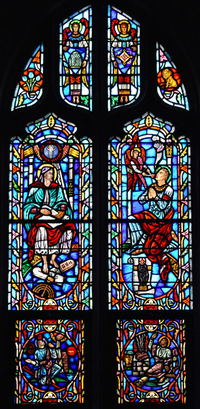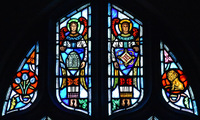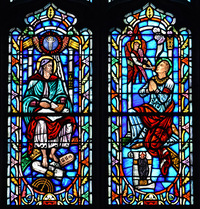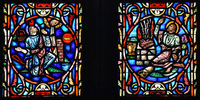Window
Building Name: First United Methodist ChurchStudio Name: Willet Hauser Architectural Glass
City: Birmingham
Date of Window: 1958
Subject/Title of Window: The Window of the Prophets
Brief Description of Subject: The following description from the book, "The Windows and Symbols of First Methodist Church Birmingham, Mich. edited by Dr. Arnold F. Runkel and privately published by the Church for its members in 1966.
THE WINDOW OF THE PROPHETS
This window portrays the stories of four of the prophets of the Old Testament. In the large medallion on the left we see Malachi. The tablets of the law and seven-branched candlestick at his feet typify the prophet's condemnation of the wickedness of the people of Israel. Above his head is the child Jesus --- 'the Sun of Rightousness --- with healing in his wings.'
In the predella below is Amos, the herdsman, holding his shepherd's staff. Amos traveled to Bethel for a religious feast and witnessed the injustices of a great city. While there, he proclaimed his vision of God standing with a plumbline, measuring the sinfulness of his people (shown in the window). The symbols accompanying the figure of Amos are derived from the seventh and eighth chapters of Amos: the locust, devouring the fruit; the plumline of the Lord as it appeared to the prophet (Amos 7:8); and the basket of summer fruit, the promise and hope of fruit to come.
Isaiah is the central figure in the scene of the right lancet. God declared his need for a servant. Isaiah pleaded he was unfit ... 'I am a man of unclean lips, and I dwell in the midst of a people of unclean lips ...' (Isaiah 6:5). Pictured in this window is the seraphim who touched and purified the prophet's lips with a live coal. The scroll of Isaiah's prophecy contains a figure of Christ treading the winepress, as Isaiah foretold the coming of the Saviour.
Elijah, pictured in the lower predella, strove to purify and fortify the faith of his people in One God; and he prepared a test of strength of his God against the gods of Baal: whichever god answered the prayer and extinguished the fire of the sacrifice would prove his divinity and be accepted as the true God. Elijah is shown kneeling in front of his altar, the jars of water nearby. The prophets of Baal shouted, cried and cut themselves; Elijah prayed. 'Then the fire of the Lord fell and consumed the burnt sacrifice and the wood and the stones and the dust, and licked up the water that was in the trench.' (I Kings 18:38)
[The symbols in the traceries at the top of this window signify four more of the tribes of Israel: olives represent the tribe of Asher; the Damascus Gate, the symbol of Simeon; the breastplate of the High Priest, symbol of Levi, and the Lion of Judah.]
The Prophets Window was presented by Mrs. Elbert S. Burns in memory of her husband.
This window portrays the stories of four of the prophets of the Old Testament. In the large medallion on the left we see Malachi. The tablets of the law and seven-branched candlestick at his feet typify the prophet's condemnation of the wickedness of the people of Israel. Above his head is the child Jesus --- 'the Sun of Rightousness --- with healing in his wings.'
In the predella below is Amos, the herdsman, holding his shepherd's staff. Amos traveled to Bethel for a religious feast and witnessed the injustices of a great city. While there, he proclaimed his vision of God standing with a plumbline, measuring the sinfulness of his people (shown in the window). The symbols accompanying the figure of Amos are derived from the seventh and eighth chapters of Amos: the locust, devouring the fruit; the plumline of the Lord as it appeared to the prophet (Amos 7:8); and the basket of summer fruit, the promise and hope of fruit to come.
Isaiah is the central figure in the scene of the right lancet. God declared his need for a servant. Isaiah pleaded he was unfit ... 'I am a man of unclean lips, and I dwell in the midst of a people of unclean lips ...' (Isaiah 6:5). Pictured in this window is the seraphim who touched and purified the prophet's lips with a live coal. The scroll of Isaiah's prophecy contains a figure of Christ treading the winepress, as Isaiah foretold the coming of the Saviour.
Elijah, pictured in the lower predella, strove to purify and fortify the faith of his people in One God; and he prepared a test of strength of his God against the gods of Baal: whichever god answered the prayer and extinguished the fire of the sacrifice would prove his divinity and be accepted as the true God. Elijah is shown kneeling in front of his altar, the jars of water nearby. The prophets of Baal shouted, cried and cut themselves; Elijah prayed. 'Then the fire of the Lord fell and consumed the burnt sacrifice and the wood and the stones and the dust, and licked up the water that was in the trench.' (I Kings 18:38)
[The symbols in the traceries at the top of this window signify four more of the tribes of Israel: olives represent the tribe of Asher; the Damascus Gate, the symbol of Simeon; the breastplate of the High Priest, symbol of Levi, and the Lion of Judah.]
The Prophets Window was presented by Mrs. Elbert S. Burns in memory of her husband.
Height: ~124"
Width: 57"
The Window of the Prophets
The Window of the Prophets canopy
Malachi, left; Isaiah, right
Amos, left; Elijah, right
The MSGC is a constantly evolving database. Not all the data that has been collected by volunteers has been sorted and entered. Not every building has been completely documented.
All images in the Index are either born-digital photographs of windows or buildings or are scans of slides, prints, or other published sources. These images have been provided by volunteers and the quality of the material varies widely.
If you have any questions, additions or corrections, or think you can provide better images and are willing to share them, please contact donald20@msu.edu






